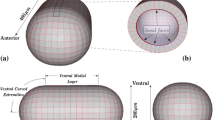Abstract
The results are presented of mathematical and computer simulation of the functioning of the central regulatory circuit (CRC) which is the system integrator of the gene networks of morphogenesis of Drosophila mechanoreceptors. The main element of the CRC is represented by the complex of Achaete-Scute (AS-C) genes, the main genes of the mechanoreceptor morphogenesis. The content level of the proteins encoded by the AS-C genes is a determining factor for initiating the development of a mechanoreceptor. We carried out a comparative study of the CRC behavior under normal conditions and in the presence of mutational changes in the Achaete-Scute complex. The results of simulation are in good accord with the available biological data.



Similar content being viewed by others
REFERENCES
T. A. Bukharina and D. P. Furman, “Genetic Control of Mechanoreceptors Formation in Drosophila melanogaster—The Description in Database ‘NEUROGENESIS’,” Inform. Vestn. VOGiS 13 (1), 186–193 (2009).
D. P. Furman and T. A. Bukharina, “Prepattern Gene Network Controlling the First Stage of the Bristle Pattern Development in Drosophila melanogaster,” Vavilov. Zh. Genetiki i Selektsii 20 (6), 832–839 (2016).
D. P. Furman and T. A. Bukharina, “The Gene Network Determining Development of Drosophila melanogaster Mechanoreceptors,” Comput. Biol. Chem. 33, 231–234 (2009).
A. S. Serebrovskii and N. P. Dubinin, “Artificial Production of Mutations and Gene Problem,” Uspekhi Eksperim. Biol. 4, 235–247 (1929).
I. J. Agol, “Step Allelomorphism in Drosophila melanogaster,” Genetics 16 (3), 254–66 (1931).
N. P. Dubinin, “Step-Allelomorphism in Drosophila melanogaster. The Allelomorphs achaete2-scute10, achaete1-scute11, and achaete3-scute13,” J. Genetics 25 (2), 163–181 (1932).
A. García-Bellido and J. F. de Celis, “The Complex Tale of the Achaete-Scute Complex: A Paradigmatic Case in the Analysis of Gene Organization and Function During Development,” Genetics 182 (3), 631–639 (2009).
J. Modolell and S. Campuzano, “The Achaete-Scute Complex as an Integrating Device,” Internat. J. Develop. Biol. 42 (3), 275–282 (1998).
P. J. Chang, Y. L. Hsiao, A. C. Tien, Y. C. Li, and H. Pi, “Negative-Feedback Regulation of Proneural Proteins Controls the Timing of Neural Precursor Division,” Development135 (18), 3021–3030 (2008).
H. Pi, S. K. Huang, C. Y. Tang, Y. H. Sun, and C. T. Chien, “Phyllopod is a Target Gene of Proneural Proteins in Drosophila External Sensory Organ Development,” Proc. Nat. Acad. Sci. U.S.A. 101 (22), 8378–8383 (2004).
V. A. Likhoshvai, V. P. Golubyatnikov, G. V. Demidenko, A. A. Evdokimov, and S. I. Fadeev, “Theory of Gene Networks,” in Systemic Computer Biology, Ed. by N. A. Kolchanov, S. S. Goncharov, V. A. Likhoshvai, and V. A. Ivanisenko (Izd. Sibir. Otdel. Ross. Akad. Nauk, Novosibirsk, 2008), Chapter 5, pp. 399–482.
T. A. Bukharina, D. P. Furman, and V. P. Golubyatnikov, “A Model Study of the Morphogenesis of D. melanogaster Mechanoreceptors: The Central Regulatory Circuit,” J. Bioinformatics and Comput. Biol.13 (01), 1540006-1–1540006-15 (2015).
L. Wilkinson, The Grammar of Graphics (Springer, New York, 2005).
M. V. Kazantsev, “Software for Modeling Early Stages of Some Biological Processes,” Vestnik NGU. Ser. Vychisl. Tekhnol. 14 (3), 25–33 (2016).
A. A. Akin’shin, V. P. Golubyatnikov, and M. V. Kazantsev, “Comparative Analysis of Some Numerical Methods for Modeling the Gene Networks with Application of Language \(R \),” in Selected Papers of International Conference “Lomonosov Readings in Altai: Fundamental Problems of Science and Education” (Izd. Altai. Gos Univ., Barnaul, 2014), pp. 548–554.
K. Soetaert, T. Petzoldt, and R. W. Setzer, “Solving Differential Equations in R: Package deSolve,” J. Statist. Software 33 (9), 1–25 (2010).
A. C. Hindmarsh, “ODEPACK, A Systematized Collection of ODE Solvers,” in Scientific Computing (Amsterdam, 1983), pp. 55–64.
N. Reeves and J. W. Posakony, “Genetic Programs Activated by Proneural Proteins in the Developing Drosophila PNS,” Developmental Cell 8, 413–425 (2005).
A. Ghysen and R. Thomas, “The Formation of Sense Organs in Drosophila: A Logical Approach,” BioEssays 25, 802–807 (2003).
M. Roark, M. F. Sturtevant, J. Emery, H. Vaessin, E. Grell, and E. Bier, “Scratch, a Pan-Neural Gene Encoding a Zinc Finger Protein Related to Snail, Promotes Neuronal Development,” Genes & Development 9, 2384–2398 (1995).
H. Jafar-Nejad, M. Acar, R. Nolo, H. Lacin, H. Pan, S. M. Parkhurst, and H. J. Bellen, “Senseless Acts as a Binary Switch During Sensory Organ Precursor Selection,” Genes & Development 17, 2966–2978 (2003).
L. M. Escuderol, E. Caminero, K. L. Schulze, H. J. Bellen, and J. Modolell, “Charlatan, a Zn-Finger Transcription Factor, Establishes a Novel Level of Regulation of the Proneural achaete/scute Genes of Drosophila,” Development 132, 1211–1222 (2005).
ACKNOWLEDGMENTS
The authors are sincerely grateful to the referee whose criticisms contributed to a significant improvement of the text of the article.
Funding
The authors were supported by the Complex Program of Basic Research of the Siberian Branch of the Russian Academy of Sciences (projects nos. 0324–2018–0021 and 0314–2018–0011) and the Russian Foundation for Basic Research (project no. 18–01–00057).
Author information
Authors and Affiliations
Corresponding authors
Additional information
Translated by L.B. Vertgeim
Rights and permissions
About this article
Cite this article
Bukharina, T.A., Akinshin, A.A., Golubyatnikov, V.P. et al. Mathematical and Numerical Models of the Central Regulatory Circuit of the Morphogenesis System of Drosophila. J. Appl. Ind. Math. 14, 249–255 (2020). https://doi.org/10.1134/S1990478920020040
Received:
Revised:
Accepted:
Published:
Issue Date:
DOI: https://doi.org/10.1134/S1990478920020040




